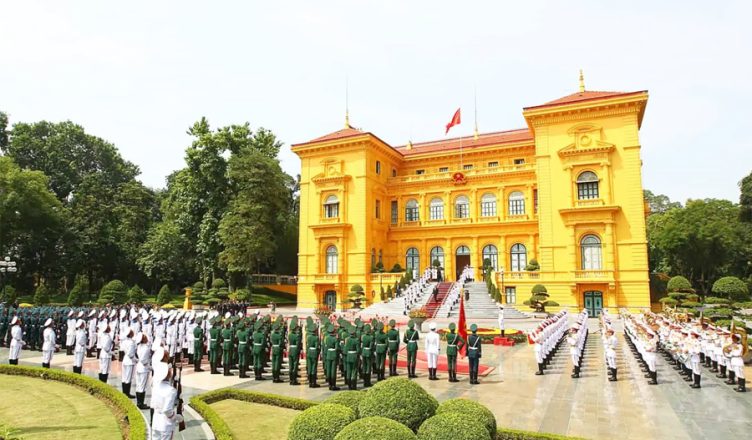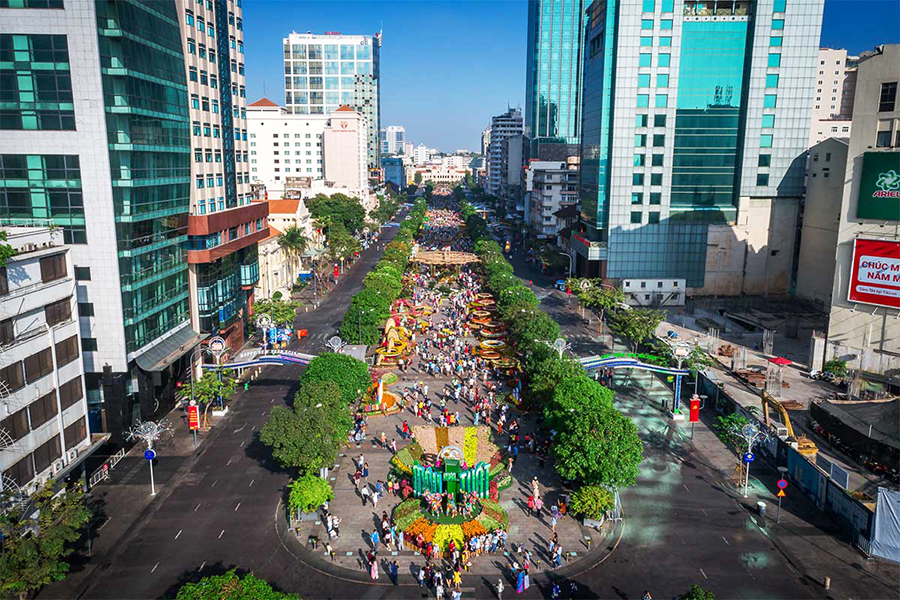Overview of Presidential Palace
The Presidential Palace, a relic that shows the revolutionary history of Vietnam, should be included in your Hanoi itinerary. Featuring typical French colonial architecture, it adds to the charm of today’s Hanoi. The Palace is a part of the Presidential Palace Historical Site complex, where President Ho Chi Minh lived and worked between December 19, 1954 and September 2, 1969. Recognized as a special national relic site, the complex is likened to a museum featuring the life of President Ho. Even though the Presidential Palace is closed to tourists, the house of Ho Chi Minh and adjacent grounds are still open to visitors.

Location: No. 2, Hung Vuong Street, Ngoc Ha Ward, Ba Dinh District, Hanoi, Vietnam
Opening hours: every day except Monday afternoons and Friday afternoons
- Summer (April – October): 7:30 – 11 am and 1:30 – 4 pm
- Winter (November – March): 8 – 11 am and 1:30 – 4 pm
Entrance fee:
- Free for Vietnamese visitors
- 40,000 VND/ticket for foreign visitors
Located in the heart of Hanoi (around 15 minutes away from Hanoi Old Quarter), the Presidential Palace is quite easy to reach by different means of transportation, such as taxi, motorbike, or even on foot. You can also take public buses passing by the area, including buses number 09, 22, 45, and 50.
History of the Presidential Palace in Hanoi, Vietnam
The Presidential Palace was built between 1900 and 1906 as the presidential area of the Governor-General of French Indochina. It was designed in a European style by a French architect named Auguste Henri Vildieu. Having taken approximately 7 years to be built, this structure was the most luxurious construction at that time.

After 1954, it was originally intended to be President Ho Chi Minh’s official residence. Yet he refused, feeling that it would be inappropriate to stay in such a large and opulent building while his people were homeless and starving. Instead, he lived nearby in a traditional Vietnamese house-on-stilts surrounded by a garden and a fish pond.
The Presidential Palace is now mainly used for meeting foreign national officials as well as important guests from all over the world coming to Vietnam.
You may also like:
Architecture of the Presidential Palace
The Presidential Palace is a three-storey building facing Hung Vuong Street. It spans an area of nearly 1,300 square meters, with 30 rooms in the building, each designed in a different style.
Standing amidst a large courtyard, the impressive yellow building is separated from the outside streets by iron fences and big gates. It features modern architecture with Renaissance and Beaux Art styles. In particular, it was built symmetrically, with a big block in the center and two blocks on both sides.

The first floor has serving rooms. A guest hall, office spaces, and a banquet hall are located on the second floor. On the third floor, there are private rooms where the Governor-general of French Indochina lived before 1954.
The Presidential Palace is surrounded by a lush garden, a fish pond, an orchard, a 91-meter-long boulevard, and the well-known Mango Alley which leads to President Ho’s stilt house.
What’s more inside the complex of the Presidential Palace Historical Site?
In addition to the Presidential Palace, the Presidential Palace Historical Site, with over 10 hectares in size, also has houses, gardens, grass, fish ponds, and walking paths.
Wooden stilt house
The wooden stilt house was the place where President Ho Chi Minh lived and worked from 1958 to 1969. It was roofed with baked clay tiles and made of Menghundor, a common wood in Vietnam. The first floor was used as the living room where the President would receive guests. The second floor, with two rooms of 10 square meters, was where he worked and slept. The house was furnished simply and neatly, reflecting the President’s modest way of life.

House No. 67
Located at the rear of the wooden house-on-stilts, House No. 67 is painted in light blue. It served as the workplace for The President from 1967 to 1969, and it was also the place where he stayed during his time of serious illness and eventually passed away.
Coming here, visitors will see 2 military maps, a ZENITH radio, a small clock near the bed, and a wall calendar that shows the time of the President’s passing: September 2, 1969, at 9:07 am.
Uncle Ho’s fish pond
When President Ho moved into the house-on-stilts in 1958, he decided to turn the natural muddy pond nearby into a fish pond. The pond is over 3,000 square meters large, with a depth of 2 meters. Various fish, such as carp and ruffe, were raised here. It was also home to mussels, which produced pearls in the pond. The President would feed them every afternoon after work.

Mango Street
Around the complex is a 200-meter-long walking path called Mango Street, which is lined with old mango trees. President Ho used to do morning exercises and take a walk after work here. The street also witnessed many memorable meetings between the President and representatives from the South during the Second Indochina War in Vietnam.
House No. 54
Before moving to the house-on-stilts, President Ho lived and worked at house No. 54, between December 1954 and May 1958.
The house has three rooms: the one near the pond where the President worked and received guests, the dining room in the middle of the house, and the last one where he would sleep.
Coming here, visitors still can see all the furniture, documents, books, and souvenirs from the President’s international friends, all of which have been kept intact as they were when he lived here.

Green garden
Together with the fish pond, this 65,000-square-meter green space makes a tranquil setting. The garden has a diverse ecosystem, in which trees and plants were planted scientifically to become a highlight in the area. They show the friendship between Vietnam and other countries.
In your journey to the capital city, in addition to the Presidential Palace, you should also explore other tourist attractions, such as Hoa Lo Prison, One Pillar Pagoda, Ngoc Son Temple, Hoan Kiem Lake, Ho Chi Minh Mausoleum, Hanoi Old Quarter, and Temple of Literature.
Map of Presidential Palace
How to get to the Presidential Palace?
The Presidential Palace is located at 2 Hung Vuong Street, Hanoi. We can get here by private vehicle or public bus.
If you ride motorbikes or drive cars on your own, remember to note the two parking spots on Ong Ich Khiem Street (opposite the Mausoleum Guard Command) and Ngoc Ha Street (the entrance to Ho Chi Minh Museum). If you take the bus, you can refer to some routes that pass by Ba Dinh Square, namely the buses number 09, 33, 22, 45, and 50.
For travelers who want to visit the Presidential Palace with private services, you can book a private tour from Vietnam Shore Excursions. Professional and knowledgeable tour guides will share profoundly many interesting stories about this place and Hanoi, as well as the local life of local people during the tour. Here are some Hanoi Tours which customers can find out and book for you and your group.
The Presidential Palace, with its distinctive architectural and historical significance, is a must-see attraction on your Vietnam trip. Here, you may find out more about President Ho Chi Minh’s simple lifestyle as well as Vietnamese history, culture, and architecture. Hopefully, all the information provided in the article will give you an overview of this place before your interesting journey to the capital city ahead!













